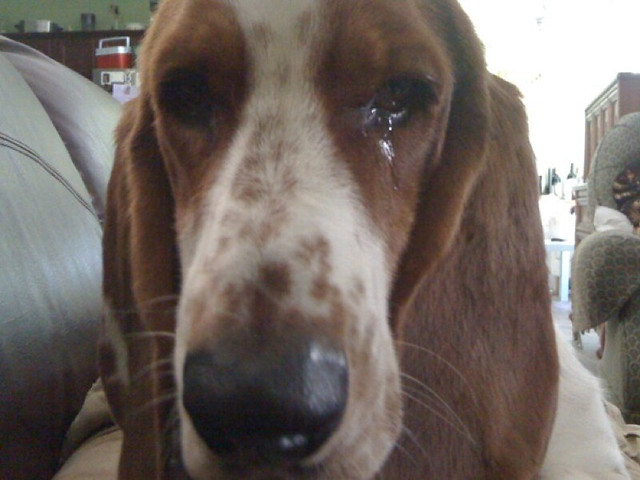Can Dogs Cry Tears Like Humans? (Interesting Fact)
Dogs are probably some of the most emotionally open animals around – whether you play with your mutt or just lie around with him on the couch, part of the joy of owning a dog is that feeling of deep connection with him and what he’s thinking. Despite this, it is important to know whether or not dogs can actually cry tears; we know that dogs can be sad, but how do they express that, and how does it differ from us? Read on to learn more!
Do dogs cry real tears?

There are a couple of answers to that. Depending on the breed, your dog can absolutely shed moisture from his or her eyes; however, that may not necessarily be emotional crying.
Our eyes tend to water when we feel rejected, or sad, or something unfortunate has happened; dogs, however, tend to cry for an entirely different reason. Don’t worry, it’s not anything you did – it’s just a little mix-up with the way their eyes work, and it happens to all kinds of dogs.
Of course, this doesn’t mean that your dog is incapable of expressing sadness to you. A dog’s form of “crying” is typically expressed through whimpering. This audible whine can mean a host of different things, and it’s up to you to determine the root of why the noise is being generated.
For instance, your dog could be whimpering because he’s trying to tell you something, such as “open the door - I gotta go potty and I don’t want to soil your rug!” It could also be due to anxiety, as he may start vocalizing when he senses you’re about to leave.
This particular instance of whining can be a bit annoying. Fortunately, they can be controlled through a bit of diligent training. Specifically, if you work with your dog to teach him the “quiet” command, eventually his anxious yelps and cries will eventually go by the wayside.
Sometimes, your buddy can start whimpering when he’s sick or he’s injured. In this case, you may start hearing him “cry” when he’s just sitting or laying somewhere or doing something routine like walking. If you observe this type of behavior, you’ll want to schedule an appointment with a vet as soon as possible.
Why do dogs "cry"?
The VCA Animal Hospital notes that dogs, like most other mammals, have tear ducts, which are necessary to provide the moisture required for normal eye function. Dogs use these tear ducts specifically to drain moisture into the mouth and throat of the dog; however, these ducts can also become blocked, which leads to tears actually flowing out of the eyes and down the cheeks.
This is known as epiphora.
A few breeds are more susceptible to epiphora than others; this chiefly depends on the shape of the dog’s face, as that can play a role in the fluid’s ability to stay within the eye. Pugs and pitbulls have trouble with epiphora more than most dogs, because of their squished faces; however, this kind of epiphora is not typically that serious.
What are some of the causes of epiphora?
Some of the issues that can cause epiphora may look rather similar to the things that may cause our eyes to water. For instance, a dog’s tears could flow as a result of sinusitis, which is a condition that occurs when a dog’s sinuses become inflamed. There’s a host of reasons why this issue can develop, from foreign objects to conjunctivitis.
Epiphora can also be caused by a congenital defect in which there’s inefficient connection between an eyelid and a tear drainage system. This could stem from a lack of connections or the formation of the excess links, thus causing poor functionality. Poodles, bulldogs, and spaniels are particularly prone to this condition.
One common breed-centric issue that could cause epiphora is ectropion. This condition is marked by an outward turning of the eyelid, and it can either be present from birth or developed through facial nerve paralysis and post-traumatic eyelid scarring. Spaniels, bloodhounds, and Great Danes are particularly susceptible to this condition.
Large, active breeds may also be prone to developing epiphora though their rambunctious tendencies. This is usually brought about by inflammation brought about due to scratches to the iris, which may be inadvertently caused by your dog trying to get a foreign object out of his eye.
When should I be worried about tears?

In many cases, epiphora is no big deal, and you and your dog can happily coexist with the condition. However, there are some symptoms that might require you to consult with your veterinarian – if your dog’s eyes never stop tearing up, there might be some harmful blocking you need to get looked at. Ideally, that moisture should be running through the dog’s tear ducts, so the more moisture is lost, the less maintained their eyes become.
Another potential trouble spot is the presence of a colored discharge in the dog’s eyes – yellow, bloody or viscous discharge is somewhat serious, and you’ll want to talk to your vet about what that might mean. Other symptoms you’ll want to look for include redness, inflammation, and corneal ulcers.
If your dog’s eyes continue to water for more than a day, you’re going to want to hit the vet post haste because you may be dealing with something serious. For instance, constant eye leakage could be leaked to issues like glaucoma. Your dog could also be dealing with a facial bone that’s fractured or even broken.
Watery eyes and tear staining
Often, tear stains will occur in dogs with epiphora. While this could be a telltale sign that excessive watery eyes may be an issue, it can also wreak some serious havoc with your pooch’s appearance. All breeds can suffer from tear staining, although the condition is particularly prevalent amongst breeds that have white coats, such as bichon frises or poodles.
There’s no getting around it: tear stains are ugly. While the most obvious sign of this condition is red-brown streaks appearing under the eyes, a dog could develop this condition on their muzzles if the tears flow freely enough.
Tear staining can develop over time due to various conditions stemming from mild epiphora. However, if your little guy develops a tear-stained face in a short period of time, it’s important that you take him to the vet immediately. A rapid onslaught of the condition could mean something serious is afoot.
What do I do with my dog’s tear stained face?
If epiphora results in your dog developing nasty looking streaks, the good news is that he doesn’t have to live with the condition. There are several ways that you can go about nipping the problem in the bud, including tactics you can deploy to help prevent the issue from returning.
For instance, if the epiphora and resultant tear staining is a result of an allergy, you may want to inspect the food your dog is eating. If it’s packed with fillers known to be disagreeable to some pooches such as corn or wheat, switching to a more all-natural brand may provide relief.
You may also want to take a look at the quality of water you’re giving your dog. While this liquid does not necessarily correlate to what’s leaking from their eyes, a mix of epiphora and poor water quality could exacerbate the spread of tear-staining. Consider using distilled or purified water in place of tap.
You can also handle the issue by deploying some daily face grooming tactics. Substances like eye wash, shampoo, or hydrogen peroxide applied to the fur daily can make those streaks gradually disappear. This needs to be done very carefully, since you’re going to be working near your pup’s peepers.
Keeping the fur around your dog’s eyes neat and trimmed will also work wonders to prevent tear staining. Doing so will lower the chances of hair - or a foreign object attached to the hair - from getting stuck in your dog’s eye, which in turn could cause epiphora and tear-staining to take place.
It should be noted that doing most of these things won’t make the issue disappear completely. They generally just enable the problem to be masked to a tolerable level. The one exception to this rule is grooming, as you can trim off the streaked fur once the affected area grows out.
Should I dry my dog's tears?

If your dog’s tear ducts are causing him problems, there are several ways you can alleviate your dog’s discomfort. If your dog has a bit of film creeping up around their eye socket as a result of their crying, you can wipe that away with a wet washcloth, making sure to keep far away from their eyes. While your dog may resist this at first, over time and with enough encouragement you may be able train your dog to sit a little more still the next time you have to clear their eyes.
In the event that you have to consult your veterinarian about chronic, severe problems with your dog’s tear ducts, they may have to re-open the tear ducts to clear out the blockage. Luckily, this doesn’t take much – all it takes is a little sedative to calm the dog, at which time the vet can flush the eyes out with their own special instruments. This will usually get the ducts opened up and allow your dog’s tear regulation to return to normal!
Now that you know more about whether or not dogs can cry tears, you can rest a little easier knowing that your dog’s eyes aren’t watering out of sadness. With a little care and maintenance, most dogs can live very happily with a little epiphora, and even more severe cases can be taken care of in a snap.

